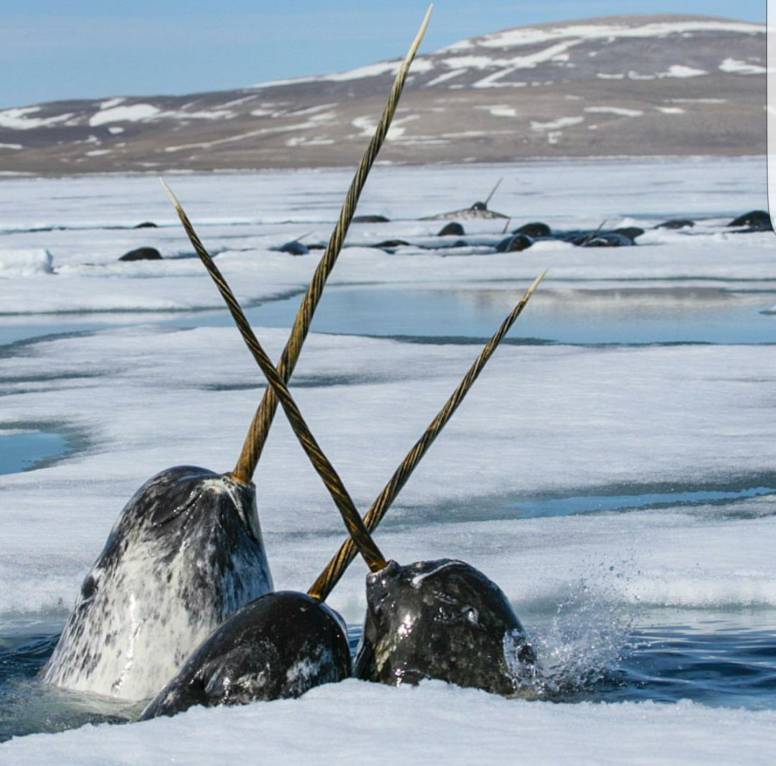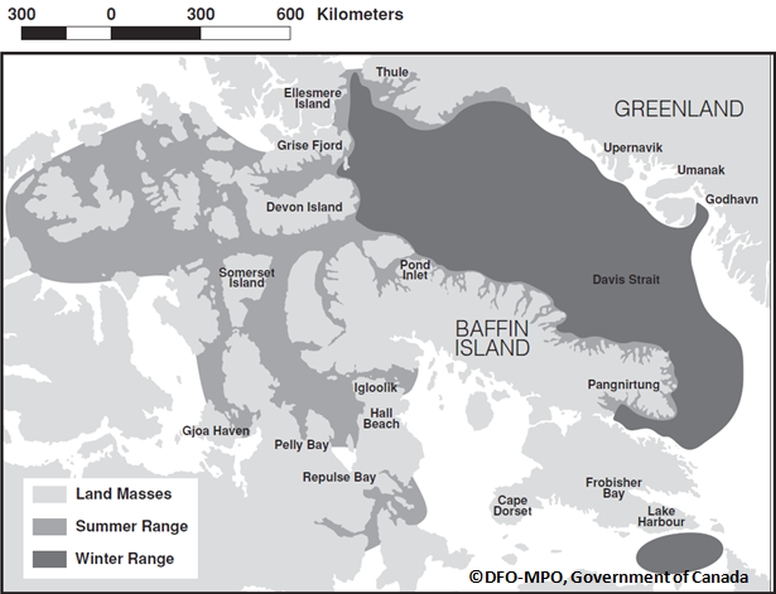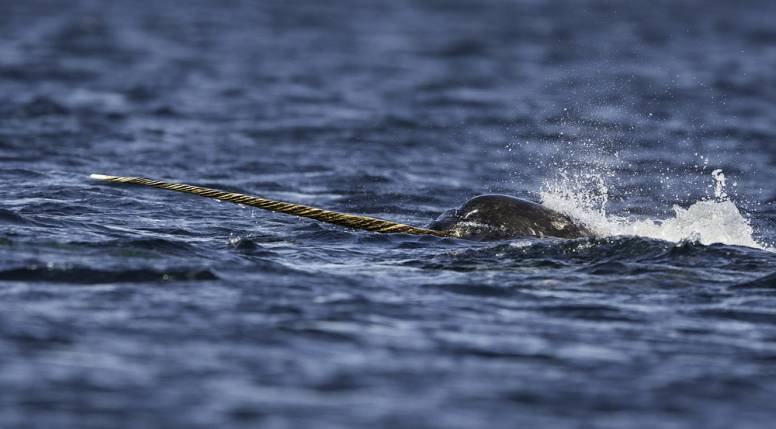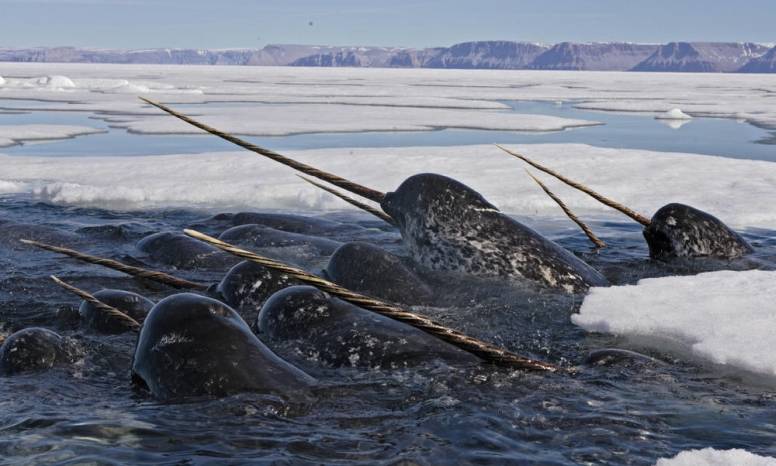Narwhal Profile
The Narwhal is a medium-sized, elusive whale, that inhabit the Arctic and Atlantic Oceans around Greenland, Canada, Norway and Russia.
They are sometimes referred to as the ‘unicorn of the sea‘, as the male Narwahl has a single long sword-like spiral tusk, which protrudes from their heads.

Narwhal Facts Overview
| Habitat: | Arctic & Atlantic Oceans |
| Location: | Near Greenland, Canada, Norway & Russia |
| Lifespan: | 90 Years |
| Size: | 13 – 18 ft (4 to 5.5 m) |
| Weight: | 1,760 – 3,530 pounds (800 – 1,600 kg) |
| Color: | Light Grey / White |
| Diet: | Fish – Flatfish, Halibut, Cod, Cuttlefish, Shrimp, Squid |
| Predators: | Polar Bears, Sharks, Walruses, Killer Whales & Humans |
| Top Speed: | 4 kph (1 meter per second) |
| No. of Species: |
1 |
| Conservation Status: |
Least Concern |
Narwhal are warm blooded, air breathing mammals, and members of the order Artiodactyla and family Monodontidae, which also includes the unusual, dorsal fin-lacking, pure white beluga whale.
The narwhal tusk is made of ivory, and is actually a tooth, that spirals out of the upper left side of the jaw and through their lip. They can extend up to 10 feet (3 meters) long and weigh as much as 22 pounds (10 kg).
The narwhal averages between 13 to 18 feet (4 to 5.5 meters) in length excluding the males spiral tusk, and weighs 1,760 to 3,530 pounds (800 to 1,600 kg ).
Narwhal live in the cracks of dense pack ice for most of the year in the Greenlandic and Canadian Arctic. Like most whales Narwhal, have predictable migration patterns. However, unlike some whale species, they don’t ever leave the Arctic waters. They make annual migrations from high Arctic summering grounds in coastal bays of West Greenland and Canada, to offshore wintering grounds in deeper waters. This is to avoid being trapped by fast ice, and stay close to easy sources of food.

Narwhal eat flatfish and halibut during the restricted winter months, which can both be found on the bottom of the sea in the Baffin Bay and Davis Strait. During the summer months they can consume cod and halibut, and will also consume cuttlefish, shrimp and squid where possible.
The IUCN classify their conservation status as ‘least concern‘, with recent estimates suggesting the total population of narwhal is upwards of 170,000. 1
Interesting Narwhal Facts
1. In 1577 the English explorer Martin Frobisher laid eyes on a dead narwhal, describing it as a ‘sea-unicorn’.
The myth of unicorn horns had circulated around Europe for centuries before his voyage, which faded as European experts become more familiar with the animals. 2
2. Both male & females are born with two small teeth embedded in their skulls, but only in males does the front left tooth grow into a spiral tusk.
Very rarely do narwhals have two tusks, or are tusks found on females. It’s estimated around 3% of female narwhals have a small tusk.

3. Around 1 in 500 narwhal males have two tusks.
This grows from the front right side of its upper jaw.
4. The tusk is an ‘ivory’ canine tooth, that spirals out of the upper left side of the jaw.
They can extend up to 10 feet (3 meters) long and weigh as much as 22 pounds (10 kg).
5. Their tusks primarily relate to mating, in a similar way to an antlers of a stag.
Males use the tusks to determine social status, dominance over other males, and compete for mating females.
6. Narwhals use their tusks to hunt for fish.
Drone footage of wild narwhals captured by Researchers from WWF-Canada shows them using their spiral tusk, to hunt fish.
They appear to flick their tusk and stun their prey, rather than stab them. 3
7. Their tusks exhibit sensory ability, due to nerve endings enabling it to detect water-salinity changes.
A study in 2014 suggests narwhals are able to use their tusks to sense changes around them in the water, like saltiness, temperature and pressure. Like all theories, this is hotly debated by scientists! 4
8. They suck prey into their mouths and swallow them whole.
The narwhals mouth is virtually toothless. This means they swim towards prey, and suck them with considerable force into their mouths.
9. Females will give birth to a calf once every 3 years.
The pregnancy lasts for about 14 months, and calves are born in the spring. Narwhals are mammals, which means they give birth, and have milk for their young. Calves are dependent on milk for around 20 months.
10. Narwhals regularly spend their winter in Davis Strait and Baffin Bay, which has less than 5% open water, due to pack ice.
Narwhals need open water to be able to breathe, but this area has a high concentration of halibut for easy feeding.
 Photo credit to Paul Nicklen writing for National Geographic, via Instagram.
Photo credit to Paul Nicklen writing for National Geographic, via Instagram.
11. Narwhals are among the deepest diving animals in the world. They can dive up to 1.8 kilometers (1.1 mile) in depth, without returning to the surface for breath, for over 25 minutes.
During winter months, male narwhals have been observed making some of the deepest dives ever recorded, with regular dives of at least 800 meters, between 10-25 times a day. These dives are virtually vertical, to maximise speed. The pressure at depths of over 800m can exceed 2200 PSI (150 atmospheres). 5
12. They have evolved to withstand incredible water pressure.
They have compressible rib cages which can be squeezed without harming them when swimming at huge depths. They also have twice the concentration of oxygen-binding myoglobin in their muscles as seals which allow them to swim at 1 meter per second underwater for 20mins, without needing a breath. 6
13. The origin of the name narwhal comes from the Icelandic words ‘nar’, meaning ‘corpse’ (in reference to its pale white color), and hvalr (whale).
‘Corpse Whale’ refers to how their skin colour resembles that of a drowned body The scientific name ‘Monodon monoceros’, is derived from Latin “one tooth, one horn”.
14. They are rarely ever seen by humans.
They are extremely difficult to see or study, as no other whales live so far north, in the most remote and coldest parts of the ocean. They took National Geographic photographer Paul Nicklen, (who grew up in the arctic Nunavut), 10 years of trying different techniques to finally track them down.
View this post on Instagram
He worked with local Inuit guides, and used an ultralight airplane to track down a pod.
15. Narwhal travel in pods between 2-3 to several hundred.
Their pods average 15-20 whales. However, sometimes multiple pods will meet in social groups and bays, reaching into the many hundreds, or thousands.
16. Narwhals are about 50% body fat and their blubber is 3-4 inches thick.
Due to the extreme cold of the arctic waters, they have significantly more blubber than an average whale, which usually has between 20-30% fat. 7
17. Narwhals are vulnerable to ice entrapment (‘Sassats’).
If narwhals fail to leave their summering grounds before Autumn, or due to sudden changes in weather conditions (such as shifts in wind, or quick drops in temperature), they can become trapped by ice. Their breathing holes can be reduced in size, or freeze completely, causing drowning. The largest entrapment recorded was in 1915 in West Greenland, where over 1,000 narwhals were trapped under the ice. 8
18. Their major predators are polar bears, which attack them at breathing holes.
However, they also have other threats, in particular Killer Whales, which have been known to attack in groups, as well as Greenland sharks, and walruses. 9
19. Queen Elizabeth I is said to have spent £10,000 on a narwhal tusk (the equivalent to £2m today), and had it placed within the crown jewels.
Shady merchants would sell Narwhal tusks as rare ‘unicorn horns’, which would fetch up to ten times their equivalent weight in gold. 10
20. Narwhal tusks are highly prized by collectors, and can fetch up to £10,000 each.
In 2009, 7 narwhal tusks were leagally put up for auction in ‘The Gentleman’s Library Sale’ at Bonhams. However, a campaign lead by the Whale and Dolphin Conservation Society managed to see them removed.11
21. Hunting of narwhals in Canada and Greenland is legal by Canadian Inuit and Greenland hunters (to help support their traditions & communities).
22. Climate change is the primary threat to narwhals.
Narwhal Fact-File Summary
Scientific Classification
| Kingdom: | Animalia |
| Phylum: | Chordata |
| Class: | Mammalia |
| Order: | Artiodactyla |
| Infraorder: | Cetacea |
| Family: | Monodontidae |
| Genus: | Monodon |
| Species Name: |
Monodon Monoceros |
Fact Sources & References
- “Monodon monoceros”, via the IUCN Red List.
- “The North-west and North-east Passages 1576-1611” via Cambridge University Press.
- K. Deamer (2017). “Narwhals Use Tusks to Stun Prey, Drone Footage Reveals”, via Live Science.
- L. Ogden (2015). “The tusks of narwhals are actually teeth that are inside-out”, via BBC Earth.
- K. Laidre (2010). “Narwhals document continued warming of southern Baffin Bay”, via Wiley Online Library.
- T. McLeish (2013). “Narwhals: Arctic Whales in a Melting World”, via Google Books.
- A. Tucker (2009). “In Search of The Mysterious Narwhal”, via Smithsonian Mag.
- M. Porslid (1918). “On “Savssats”: A Crowding of Arctic Animals at Holes in the Sea Ice”, via JSTOR.
- “Killer Whales Attack Pod of Narwhal”, via PBS.org.
- A. Coates (2017). “The other ivory trade: Narwhal, walrus and… mammoth”, via The Indepedent.
- M. McCarthy (2009). “War against ivory trade takes to the sea”, via The Indepedent.
- T. Shadbolt et al (2015). “Breaking The Ice: International Trade In Narwhals, in the Context of Changing Artic’ via A Traffic WWF-Canda Report.
- C. Kennedy (2012). “The Narwhal’s Tale: Surviving Sea Ice Change’ via Climate.gov.
